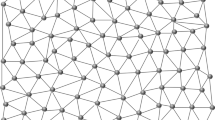Abstract
In human communication, people do not always express the emotions they feel inside. In this paper, we propose a method to calculate “expressed emotions” from “aroused emotions” based on the personality of the agent, the situation of the conversation, and relationship with the partner. We consider five types of personality factors (extroversion, agreeableness, conscientiousness, neuroticism, and openness to experience) based on the “Big 5” model. The effect of each personality factor is calculated to amplify/suppress the aroused emotions. The amplification/suppression effects from five personality factors are collated and the degree of aroused emotion is calculated.
Preview
Unable to display preview. Download preview PDF.
Similar content being viewed by others
References
Ichimura, T., Mera, K.: Dialogue system with emotion through computer network, Japan Patent No. 2005-237668 (2005)
Mera, K.: Emotion Orientated Intelligent Interface, Doctoral Dissertation, Tokyo Metro-politan Institute of Technology, Graduate School of Engineering (2003)
Ichimura, T., Mera, K., et al.: An Emotional Interface with Facial Expression by Sand Glass Type Neural Network and Emotion Generating Calculations Method. In: Proc. of the International Symposium on Measurement, Analysis and Modeling of Human Functions, pp. 275–280 (2001)
Ichimura, T., Mera, K., et al.: Emotional Interface for Human Feelings by Mobile Phone. In: Proc. of KES 2002, vol. 1, pp. 708–712 (2002)
Ishida, H., Ichimura, T., et al.: Classification of Facial Expressions using Sandglass-type Neural Networks. In: Proc. of FAN 2000, pp. 201–204 (2000) (in Japanese)
Huffman, K., et al.: Psychology in Action, 3rd edn. Wiley and Sons Inc., Chichester (1994)
Eysenck, H.J.: Biological dimensions of personality. In: Pervin, L.A. (ed.) Handbook of personality: Theory and research. Guilford Press, New York (1990)
Goldberg, L.R.: The structure of phenotypic personality traits. American Psychologist 48, 26–34 (1993)
Author information
Authors and Affiliations
Editor information
Editors and Affiliations
Rights and permissions
Copyright information
© 2006 Springer-Verlag Berlin Heidelberg
About this paper
Cite this paper
Mera, K., Ichimura, T. (2006). Expressed Emotion Calculation Method According to the User’s Personality. In: Gabrys, B., Howlett, R.J., Jain, L.C. (eds) Knowledge-Based Intelligent Information and Engineering Systems. KES 2006. Lecture Notes in Computer Science(), vol 4253. Springer, Berlin, Heidelberg. https://doi.org/10.1007/11893011_95
Download citation
DOI: https://doi.org/10.1007/11893011_95
Publisher Name: Springer, Berlin, Heidelberg
Print ISBN: 978-3-540-46542-3
Online ISBN: 978-3-540-46544-7
eBook Packages: Computer ScienceComputer Science (R0)




